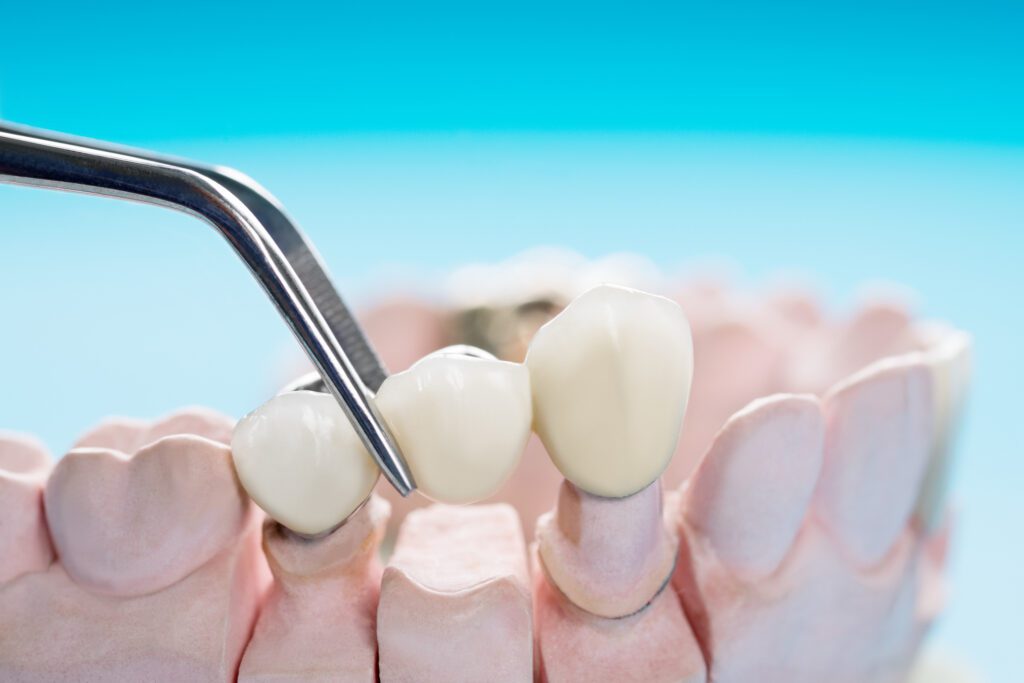A dental bridge is a false tooth or teeth that restore one or more consecutive lost teeth. Bridges fill the gap left by missing teeth to renew the function and aesthetics of the smile. Dr. Trace Bridges provides dental bridge treatment in Tulsa, OK, to restore missing teeth and improve bite function. Dr. Bridges also provides additional restorative dentistry services to patients in his Tulsa, OK, dental office.
A dental bridge replaces a lost tooth or teeth with a pontic or false tooth. Natural teeth or implants can help support this false tooth. Dental bridges fill the gap in the mouth left by one or more consecutive missing teeth. “Bridging the gap” with a dental bridge can prevent missing teeth problems, including shifting teeth, tooth decay, and more.

Types of Dental Bridges
Dental bridges are fixed or removable. A fixed (non-removable) bridge uses support from natural teeth or implants to stay in place. Typically, a removable bridge is often less costly than a fixed bridge. However, a removable bridge is less stable than a fixed bridge.
There are multiple common types of dental bridges:
- Traditional Bridge: A traditional bridge replaces tooth gaps with false teeth secured by crown-capped teeth. This bridge uses false teeth on a metal or ceramic base. A dentist uses natural teeth covered by dental crowns on either side of the lost tooth or teeth to support the pontic.
- Cantilever Bridge: A Cantilever bridge uses support from one side of the missing tooth gap. Like a traditional bridge, this bridge uses a natural, crown-capped tooth to support a false tooth.
- Maryland Bridge: This bridge is a false tooth with metal wings. A dentist places the tooth by bonding the metal wings to the back of the teeth on either side of the tooth gap.
- Implant-Supported Bridge: This bridge uses support from titanium implant posts instead of natural teeth. These posts replace missing teeth at the root and help provide more stability to false teeth.
Our dental office prefers traditional and implant bridges. Bridges help fill the gap left by missing teeth. They also prevent shifting teeth and further tooth loss. Waiting to replace a missing tooth or a row of lost teeth can lead to many missing tooth problems. A bridge or other custom-made restoration will preserve your dental health.
Traditional vs. Implant Dental Bridges
When many people think of a dental bridge, they think of false teeth supported by natural teeth. A traditional dental bridge uses support from natural teeth covered with dental crowns. We may not recommend a traditional bridge for some patients because these healthy teeth require preparation. Additionally, dental bridges sit on the gums and do not support the bone or tissue.
That’s where dental implants come into the picture. Dental implants can replace a single missing tooth or multiple teeth. They support false teeth at the root. Implants support healthy bones and gums because they are inserted into the jaw bone. Once implants fuse to the jaw bone, they ensure that bridges stay secure.
Dental bridges can replace one to four missing teeth in a row. If you have a single missing tooth, we can replace it with a single implant. That way, you do not need to prepare healthy natural teeth to support your restoration needlessly.
Before bridge treatment, we will examine your smile and determine if you are a candidate for implants. We will also consider your budget and goals before treatment. You may benefit from a traditional bridge for a more economical restoration. However, if you want to make more of an initial investment but want a longer-lasting restoration, implants may be right for you.
Dental implants require more preparation than traditional bridge treatment. We may recommend bone grafting if you receive dental implants to secure your bridge but lack jaw bone tissue. However, we will ensure good oral health before any restorative treatment.
Dental Bridge Treatment in Tulsa, OK
Restorative dental treatment begins with dental X-rays. We take X-rays to examine your teeth, gums, and jaw. Using these X-rays, we can plan dental bridges and implant placement.
Traditional dental bridge treatment requires tooth preparation for the teeth on either side of the tooth gap. During this preparation, we numb the teeth and remove a small portion of the outer layer of the teeth. Preparation ensures the crowns will fit properly.
After preparation, we create custom dental crowns using scans of the mouth and an in-office milling machine. We can make same-day dental crowns using CEREC and CAD/CAM technology. Then, we create a prosthetic to cover the tooth gap and secure the bridge with the crown-capped teeth.
If you choose an implant bridge, you will require implant surgery before receiving your final bridge. First, we place the implant posts in the jaw bone. We wait until they fully heal before placing the dental bridge.
The implants can take three to six months to fuse with the jaw bone. However, dental implant posts offer a stable, permanent foundation for the final dental bridge. Once your implants heal, we will secure the bridge with the implants.
How to Care for a Dental Bridge
You can clean your bridge with a toothbrush and toothpaste. We often recommend an interdental brush to simplify cleaning around restorations like bridges. Flossing before brushing with regular floss or a brush will prevent food and bacteria buildup on and around the bridge. When brushing, use a soft-bristled brush and non-abrasive toothpaste.
We recommend you continue visiting our office for regular dental cleanings and exams. At these appointments, we will clean your teeth and gums. We will also examine your bridge to ensure it looks and feels natural. A dental bridge can last 15 or more years with the proper care.
Dental Bridge FAQs
Here, we answer the top questions that our patients ask about dental bridge treatment in Tulsa, OK:
What is a dental bridge?
A dental bridge is a custom dental device Dr. Bridges will use to replace one or more missing teeth. It “bridges” the gap between two teeth. Dr. Bridges will custom design a bridge that consists of false teeth, called pontics, and dental crowns. The pontic is held in place by dental crowns that Dr. Bridges will cement onto the teeth on each side of the gap.
Who should get a dental bridge?
We will suggest a dental bridge to patients who have one or more missing teeth. However, it is vital to have healthy teeth on either side of the gap to support the bridge. A bridge can help repair your smile and improve your ability to talk and chew food. replacing your teeth with a bridge will also stop your remaining healthy teeth from shifting out of position.
How long does it take to get used to a dental bridge?
With a new foreign object in your mouth, it is natural for it to feel uncomfortable. For most patients, it takes a few weeks to get used to the dental bridge. At first, you may feel some discomfort or sensitivity. This will go away over time. Dr. Bridges will provide you with instructions on how to care for your bridge and manage any discomfort.
Does a dental bridge feel natural?
Yes, a dental bridge can feel natural once it’s in place. After the procedure, most people say that their bridge feels comfortable and like a regular tooth. It can match the look, feel, and function of your natural teeth so you can chew, speak, and smile with confidence.
While it may take a little time to adjust to, after the healing period, it will blend in with your mouth, and you’ll likely forget it’s not a real tooth!
How long will my dental bridges last?
With proper care, your new dental restoration will last between 5 to 15 years, or even longer. Regular dental office visits and good oral hygiene are crucial for extending the life of your bridge.
What are the risks of dental bridges?
There are not many risks of getting a dental bridge. The most common ones include tooth decay under the crowns and gum disease. However, if you take good care of your gums and teeth and floss under the bridge every day, you can prevent these oral health issues. The least common risk is the dental bridge falling out. This is possible only when the supporting teeth are not strong enough.
Can I remove my dental bridge?
You will not be able to remove your dental bridge. They are fixed dental restorations that you will be unable to remove. Dr. Bridges will cement it to your surrounding teeth or secure it to dental implants. However, if you are having issues with the bridge, such as discomfort or damage, a dentist can remove it for repair or replacement.
Are dental bridges covered by insurance?
Yes, dental bridges are often covered by dental insurance, but it depends on your specific plan. Many insurance plans provide coverage for bridges when they are considered medically necessary, like replacing missing teeth to restore your ability to chew and speak properly. However, the coverage can vary by plan, and some plans may only cover a part of the cost.
Restore Missing Teeth Today
Do you need to replace one or more missing teeth? Call our dental office so we can begin to plan your custom dental bridge in Tulsa, OK, at 918-347-1114. You can also schedule a dental consultation on our website. We will help you find the best restorative option for your smile.
